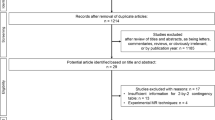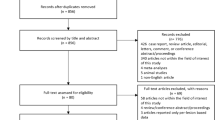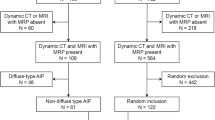Abstract
Objectives
To determine informational CT findings for distinguishing autoimmune pancreatitis (AIP) from pancreatic ductal adenocarcinoma (PDAC) and to review their diagnostic accuracy.
Methods
A systematic and detailed literature review was performed through PubMed, EMBASE, and the Cochrane library. Similar descriptors to embody the identical image finding were labeled as a single CT characteristic. We calculated the pooled diagnostic odds ratios (DORs) of each CT characteristic using a bivariate random-effects model.
Results
A total of 145 various descriptors from 15 studies (including 562 AIP and 869 PDAC patients) were categorized into 16 CT characteristics. According to the pooled DOR, 16 CT characteristics were classified into three groups (suggesting AIP, suggesting PDAC, and not informational). Seven characteristics suggesting AIP were diffuse pancreatic enlargement (DOR, 48), delayed homogeneous enhancement (DOR, 46), capsule-like rim (DOR, 34), multiple pancreatic masses (DOR, 16), renal involvement (DOR, 15), retroperitoneal fibrosis (DOR, 13), and bile duct involvement (DOR, 8). Delayed homogeneous enhancement showed a pooled sensitivity of 83% and specificity of 85%. The other six characteristics showed relatively low sensitivity (12–63%) but high specificity (93–99%). Four characteristics suggesting PDAC were discrete pancreatic mass (DOR, 23), pancreatic duct cutoff (DOR, 16), upstream main pancreatic duct dilatation (DOR, 8), and upstream parenchymal atrophy (DOR, 7).
Conclusion
Eleven CT characteristics were informational to distinguish AIP from PDAC. Diffuse pancreatic enlargement, delayed homogeneous enhancement, and capsule-like rim suggested AIP with the highest DORs, whereas discrete pancreatic mass suggested PDAC. However, pooled sensitivities of informational CT characteristics were moderate.
Clinical relevance statement
This meta-analysis underscores eleven distinctive CT characteristics that aid in differentiating autoimmune pancreatitis from pancreatic adenocarcinoma, potentially preventing misdiagnoses in patients presenting with focal/diffuse pancreatic enlargement.
Key Points
• Diffuse pancreatic enlargement (pooled diagnostic odds ratio [DOR], 48), delayed homogeneous enhancement (46), and capsule-like rim (34) were CT characteristics suggesting autoimmune pancreatitis.
• The CT characteristics suggesting autoimmune pancreatitis, except delayed homogeneous enhancement, had a general tendency to show relatively low sensitivity (12–63%) but high specificity (93–99%).
• Discrete pancreatic mass (pooled diagnostic odds ratio, 23) was the CT characteristic suggesting pancreatic ductal adenocarcinoma with the highest pooled DORs.





Similar content being viewed by others
Abbreviations
- AIP:
-
Autoimmune pancreatitis
- CI:
-
Confidence interval
- DOR:
-
Diagnostic odds ratio
- ERP:
-
Endoscopic retrograde pancreatography
- EUS:
-
Endoscopic ultrasonography
- MPD:
-
Main pancreatic duct
- MRCP:
-
Magnetic resonance cholangiopancreatography
- PDAC:
-
Pancreatic ductal adenocarcinoma
- QUADAS-2:
-
The quality assessment of diagnostic accuracy studies
References
Takahashi M, Fujinaga Y, Notohara K et al (2020) Diagnostic imaging guide for autoimmune pancreatitis. Jpn J Radiol 38:591–612
Nagpal SJS, Sharma A, Chari ST (2018) Autoimmune pancreatitis. Am J Gastroenterol 113:1301
Kamisawa T, Zen Y, Nakazawa T, Okazaki K (2018) Advances in IgG4-related pancreatobiliary diseases. Lancet Gastroenterol Hepatol 3:575–585
Lohr JM, Vujasinovic M, Rosendahl J, Stone JH, Beuers U (2022) IgG4-related diseases of the digestive tract. Nat Rev Gastroenterol Hepatol 19:185–197
Moon SH, Kim MH, Park DH et al (2008) Is a 2-week steroid trial after initial negative investigation for malignancy useful in differentiating autoimmune pancreatitis from pancreatic cancer? A prospective outcome study. Gut 57:1704–1712
Manfredi R, Frulloni L, Mantovani W, Bonatti M, Graziani R, Pozzi Mucelli R (2011) Autoimmune pancreatitis: pancreatic and extrapancreatic MR imaging-MR cholangiopancreatography findings at diagnosis, after steroid therapy, and at recurrence. Radiology 260:428–436
Kamisawa T, Chari ST, Giday SA et al (2011) Clinical profile of autoimmune pancreatitis and its histological subtypes: an international multicenter survey. Pancreas 40:809–814
Javed AA, Wright MJ, Ding D et al (2021) Autoimmune pancreatitis: a critical analysis of the surgical experience in an era of modern diagnostics. Pancreas 50:556–563
Nikolic S, Ghorbani P, Pozzi Mucelli R et al (2022) Surgery in autoimmune pancreatitis. Dig Surg 39:32–41
Shimosegawa T, Chari ST, Frulloni L et al (2011) International consensus diagnostic criteria for autoimmune pancreatitis: guidelines of the International Association of Pancreatology. Pancreas 40:352–358
Yoon SB, Moon SH, Song TJ, Kim JH, Kim MH (2021) Endoscopic ultrasound-guided fine needle aspiration versus biopsy for diagnosis of autoimmune pancreatitis: systematic review and comparative meta-analysis. Dig Endosc 33:1024–1033
Lee SC, Yang CH, Chang CT, Yu KH (2021) Diagnostic utility of serum IgG4 in autoimmune pancreatitis: an updated comprehensive systematic review and meta-analysis. J Clin Gastroenterol. https://doi.org/10.1097/MCG.0000000000001612
Lee S, Kim JH, Kim SY et al (2018) Comparison of diagnostic performance between CT and MRI in differentiating non-diffuse-type autoimmune pancreatitis from pancreatic ductal adenocarcinoma. Eur Radiol 28:5267–5274
Yoon SB, Jeon TY, Moon SH, Lee SM, Kim MH (2022) Systematic review and meta-analysis of MRI features for differentiating autoimmune pancreatitis from pancreatic adenocarcinoma. Eur Radiol 32:6691–6701
Ha J, Choi SH, Kim KW, Kim JH, Kim HJ (2022) MRI features for differentiation of autoimmune pancreatitis from pancreatic ductal adenocarcinoma: a systematic review and meta-analysis. Dig Liver Dis 54:849–856
Page MJ, McKenzie JE, Bossuyt PM et al (2021) The PRISMA 2020 statement: an updated guideline for reporting systematic reviews. BMJ 372:n71
Schardt C, Adams MB, Owens T, Keitz S, Fontelo P (2007) Utilization of the PICO framework to improve searching PubMed for clinical questions. BMC Med Inform Decis Mak 7:16
Whiting PF, Rutjes AW, Westwood ME et al (2011) QUADAS-2: a revised tool for the quality assessment of diagnostic accuracy studies. Ann Intern Med 155:529–536
You MW, Yun SJ (2019) Differentiating between hepatocellular carcinoma and intrahepatic cholangiocarcinoma using contrast-enhanced MRI features: a systematic review and meta-analysis. Clin Radiol 74:406 e409–406 e418
Kim HY, Park JH, Lee YJ, Lee SS, Jeon JJ, Lee KH (2018) Systematic review and meta-analysis of CT features for differentiating complicated and uncomplicated appendicitis. Radiology 287:104–115
Kamisawa T, Imai M, Yui Chen P et al (2008) Strategy for differentiating autoimmune pancreatitis from pancreatic cancer. Pancreas 37:e62-67
Takahashi N, Fletcher JG, Fidler JL, Hough DM, Kawashima A, Chari ST (2008) Dual-phase CT of autoimmune pancreatitis: a multireader study. AJR Am J Roentgenol 190:280–286
Chang WI, Kim BJ, Lee JK et al (2009) The clinical and radiological characteristics of focal mass-forming autoimmune pancreatitis: comparison with chronic pancreatitis and pancreatic cancer. Pancreas 38:401–408
Chari ST, Takahashi N, Levy MJ et al (2009) A diagnostic strategy to distinguish autoimmune pancreatitis from pancreatic cancer. Clin Gastroenterol Hepatol 7:1097–1103
Kawai Y, Suzuki K, Itoh S, Takada A, Mori Y, Naganawa S (2012) Autoimmune pancreatitis: assessment of the enhanced duct sign on multiphase contrast-enhanced computed tomography. Eur J Radiol 81:3055–3060
Kim JH, Kim MH, Byun JH et al (2012) Diagnostic strategy for differentiating autoimmune pancreatitis from pancreatic cancer: is an endoscopic retrograde pancreatography essential? Pancreas 41:639–647
Muhi A, Ichikawa T, Motosugi U et al (2012) Mass-forming autoimmune pancreatitis and pancreatic carcinoma: differential diagnosis on the basis of computed tomography and magnetic resonance cholangiopancreatography, and diffusion-weighted imaging findings. J Magn Reson Imaging 35:827–836
Naitoh I, Nakazawa T, Hayashi K et al (2012) Clinical differences between mass-forming autoimmune pancreatitis and pancreatic cancer. Scand J Gastroenterol 47:607–613
Sun GF, Zuo CJ, Shao CW, Wang JH, Zhang J (2013) Focal autoimmune pancreatitis: radiological characteristics help to distinguish from pancreatic cancer. World J Gastroenterol 19:3634–3641
Zaheer A, Singh VK, Akshintala VS et al (2014) Differentiating autoimmune pancreatitis from pancreatic adenocarcinoma using dual-phase computed tomography. J Comput Assist Tomogr 38:146–152
Furuhashi N, Suzuki K, Sakurai Y, Ikeda M, Kawai Y, Naganawa S (2015) Differentiation of focal-type autoimmune pancreatitis from pancreatic carcinoma: assessment by multiphase contrast-enhanced CT. Eur Radiol 25:1366–1374
Lee-Felker SA, Felker ER, Kadell B et al (2015) Use of MDCT to differentiate autoimmune pancreatitis from ductal adenocarcinoma and interstitial pancreatitis. AJR Am J Roentgenol 205:2–9
Matsubayashi H, Satoh T, Ishikawa K et al (2021) Comparison of five-phase computed tomography images of type 1 autoimmune pancreatitis and pancreatic cancer: emphasis on cases with atypical images. Pancreatology 21:666–675
Zhao Y, Li F, An N, Peng Z (2021) Atypical enhanced computed tomography signs of pancreatic cancer and its differential diagnosis from autoimmune pancreatitis. Gland Surg 10:347–354
Gardner TB, Levy MJ, Takahashi N, Smyrk TC, Chari ST (2009) Misdiagnosis of autoimmune pancreatitis: a caution to clinicians. Am J Gastroenterol 104:1620–1623
He M, Wang X, Xu J et al (2022) Diffuse involvement of pancreas is not always autoimmune pancreatitis. Acad Radiol 29:1523–1531
Sahani DV, Sainani NI, Deshpande V, Shaikh MS, Frinkelberg DL, Fernandez-del Castillo C (2009) Autoimmune pancreatitis: disease evolution, staging, response assessment, and CT features that predict response to corticosteroid therapy. Radiology 250:118–129
Uehara T, Hamano H, Kawakami M et al (2008) Autoimmune pancreatitis-associated prostatitis: distinct clinicopathological entity. Pathol Int 58:118–125
Ha J, Choi SH, Byun JH et al (2021) Meta-analysis of CT and MRI for differentiation of autoimmune pancreatitis from pancreatic adenocarcinoma. Eur Radiol 31:3427–3438
Rhee H, Park MS (2021) The role of imaging in current treatment strategies for pancreatic adenocarcinoma. Korean J Radiol 22:23–40
Moon SH, Kim MH (2012) The role of endoscopy in the diagnosis of autoimmune pancreatitis. Gastrointest Endosc 76:645–656
Kawa S, Kamisawa T, Notohara K et al (2020) Japanese clinical diagnostic criteria for autoimmune pancreatitis, 2018: revision of Japanese clinical diagnostic criteria for autoimmune pancreatitis, 2011. Pancreas 49:e13–e14
Yoon SB, Moon SH, Kim JH, Song TJ, Kim MH (2020) The use of immunohistochemistry for IgG4 in the diagnosis of autoimmune pancreatitis: a systematic review and meta-analysis. Pancreatology 20:1611–1619
Masamune A, Kikuta K, Hamada S et al (2020) Nationwide epidemiological survey of autoimmune pancreatitis in Japan in 2016. J Gastroenterol 55:462–470
Acknowledgements
The review methodology for this study was preregistered on the PROSPERO database (CRD42021277517).
Funding
The authors state that this work has not received any funding.
Author information
Authors and Affiliations
Corresponding author
Ethics declarations
Guarantor
The scientific guarantor of this publication is Sung-Hoon Moon.
Conflict of interest
The authors of this manuscript declare no relationships with any companies, whose products or services may be related to the subject matter of the article.
Statistics and biometry
One of the authors (Seung Bae Yoon) has significant statistical expertise.
Informed consent
Written informed consent was not required for this study because this study was a systematic review and meta-analysis.
Ethical approval
Institutional review board approval was not required because this study was a systematic review and meta-analysis.
Methodology
• meta-analysis
• diagnostic study
• performed at multiple institutions
Additional information
Publisher's note
Springer Nature remains neutral with regard to jurisdictional claims in published maps and institutional affiliations.
Supplementary Information
Below is the link to the electronic supplementary material.
Rights and permissions
Springer Nature or its licensor (e.g. a society or other partner) holds exclusive rights to this article under a publishing agreement with the author(s) or other rightsholder(s); author self-archiving of the accepted manuscript version of this article is solely governed by the terms of such publishing agreement and applicable law.
About this article
Cite this article
Yoon, S.B., Jeon, T.Y., Moon, SH. et al. Differentiation of autoimmune pancreatitis from pancreatic adenocarcinoma using CT characteristics: a systematic review and meta-analysis. Eur Radiol 33, 9010–9021 (2023). https://doi.org/10.1007/s00330-023-09959-5
Received:
Revised:
Accepted:
Published:
Issue Date:
DOI: https://doi.org/10.1007/s00330-023-09959-5




